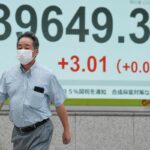
U.S. Treasury yields rose Thursday after reports that the White House had discussed the possibility of a limited trade agreement with Beijing, sparking a selloff in haven assets like government bonds.
What are Treasurys doing?
The 10-year Treasury note yield TMUBMUSD10Y, +2.09% climbed 5.6 basis points to 1.789%, around a six-week high, while the two-year note rate TMUBMUSD02Y, +2.19% was up 5.3 basis points to 1.723%, also a nearly six-week high. The 30-year bond yield TMUBMUSD30Y, +1.83% advanced 5.5 basis points to a five-week high of 2.263%.
The German 10-year government bond yield TMBMKDE-10Y, +7.58% was up 4.3 basis points to negative-0.521%, while the 10-year Italian bond yield TMBMKIT-10Y, -13.29% fell 12 basis points to 0.862%, briefly scraping a record low of 0.79%.
What’s driving Treasurys?
Investors saw some positive developments on the international trade front. Bloomberg News reported that the White House was contemplating a limited trade deal with China. In return for promises on agricultural purchases and intellectual-property issues, the U.S. would delay and take away some tariffs on Chinese imports. But a senior White House official later denied the report to CNBC.
Late Wednesday, President Donald Trump delayed a tariff increase on around $250 billion in Chinese imports that had been originally slated to start on Oct. 1. Trump postponed the increase to Oct. 15, to avoid conflicting with the 70th anniversary of the Chinese Communist Party’s rule.
The Wall Street Journal reported that Beijing was looking to split trade negotiations into two tracks, separating the more thornier national security issues from less contentious trade concerns, in the hopes of advancing stalled trade talks with the U.S.
A lackluster U.S. debt auction for 30-year maturities also weighed on prices for government paper, lifting yields. The auction tailed by 1.3 basis points, a sign that the bond sale struggled to draw sufficient demand.
The European Central Bank initially sparked buying in global bond markets at the start of the trading session after cutting its deposit rate by 10 basis points to negative-0.5%, as expected. More importantly, it announced it would buy €20 billion ($22 billion) of bonds every month.
But analysts said the level of the ECB’s stimulus measures appeared to disappoint investors who had piled into long-term European debt ahead of the meeting.
Market participants also considered an update on U.S. inflationary pressures. The U.S. consumer price data for August rose 0.1%, but climbed 0.3% on the core gauge stripping out for food and energy prices. Underlying inflation, stripping out food and energy prices rose 2.4%, the fastest rate in 13 months.
What did market participants say?
“Stock markets are desperate for an end to tariffs, and bond markets will take weeks to get used the trade whipsaw,” said Jim Vogel, an interest-rate strategist at FTN Financial.
“On the surface, the [ECB] announcement is somewhat disappointing relative to market expectations as far as today’s rate cut is concerned (‘only’ 10 bps) but also with regard to the amount of monthly purchases under the re-introduced asset purchase program APP (‘only’ 20 bn),” noted Andreas Billmeier, a sovereign analyst at Western Asset Management.









